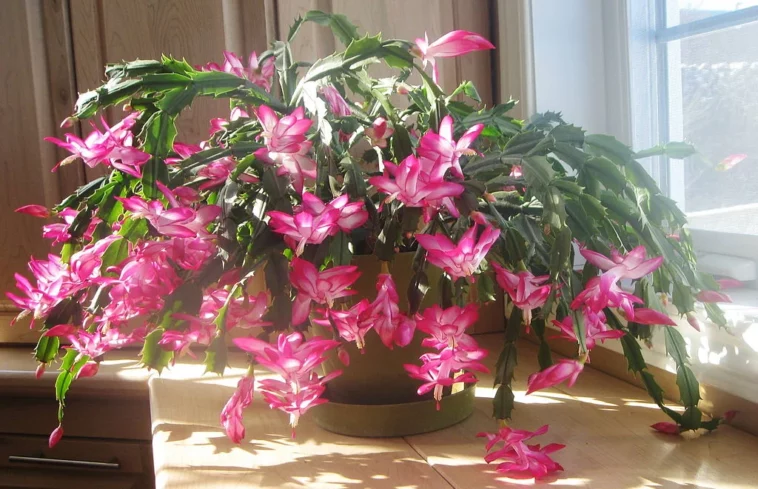Table of Contents
How to Care for Schlumbergera truncata
The Schlumbergera truncata is one of a genus of six species, all of which are members of the cacti family, that are known for their spineless structure and striking elongated flowers.
Often recognized by its common name Christmas Cactus, it was named so for the time of year in which its flowers normally bloom. Schlumbergera actually come in several often confused, but ultimately interchangeable, varieties.
The cacti are native to the rainforests of Brazil where they normally grow as epiphytes on other plant life, but they have also been known to spring up in cracks between rocks. When properly cared for they can live up to 100 years as houseplants.
If you have recently purchased or received a Schlumbergera and are wondering how to properly care for it, read on below for everything you will need to know to someday have a century old Christmas Cactus of your own.
What does your Schlumbergera truncate require?
The first thing to realize is that Schlumbergera truncata and Schlumbergera buckleyi are often confused for one another, though most you will find are hybrids of the two and the latter is rarely found for sale.
Known as Thanksgiving Cactus and Christmas Cactus respectively, you can tell the two apart by their varied blooms, truncata blooms are erect while buckleyi’s droop down. Luckily, there are no substantial differences in how you would care for any of the Schlumbergera plants.
Though these plants are often referred to as cacti, they actually do very poorly in hot and arid conditions that are normally associated with cactus.
If that comes as surprise to you, it is because Schlumbergera are actually native to mountainous rain forests and thus need a fair amount of light, heat and moisture.
To find out what conditions your Schlumbergera will best thrive in, be sure to read on below.
Light Requirements
These cacti love lots of indirect sunlight. The brighter the better so feel free to place it in an east-facing window or bright bathroom sill. If you so choose, during the summer months you can place your cactus in a shady part of your garden.
Just be sure to keep Schlumbergera out of direct sunlight, however, as this will harm the leaves and cause them to yellow or bleach. You can tell if your plant is getting too much light as the stems will begin to turn rouge.
If your cactus fails to bloom, however, this is most likely due to a lack of exposure to light.
Temperature Requirements
Your Schlumbergera will need a constant daytime temperature of above 70-degrees Fahrenheit. At night indoors it can tolerate slightly cooler temperatures, down to 60-degrees Fahrenheit.
During the summer you may choose to bring you cactus outside, this is fine as long as it stays out of direct sunlight and comes inside if the temperature will fall to below 50-degrees Fahrenheit overnight.
One additional tip if you are hoping for a second blooming in February is to expose your cactus to several nights of 40-degree Fahrenheit temperatures to force them to flower again.
Soil Requirements
The most important aspect of your soil choice is that it drains well. Make sure when potting your plant to use a pot with a drainage hole and a good potting mix specifically designed for succulents and cacti.
If you use regular potting soil for your Schlumbergera your cactus will be stuck in soil that doesn’t drain fast enough and stays too wet.
Humidity Requirements
For a cactus, Schlumbergera require a surprising amount of humidity, so be sure to keep it away from drafty or arid areas.
If you are worried about the humidity levels around your plant being too low, bring it into either a bright bathroom or kitchen, these are places where the natural humidity should be higher.
If that still isn’t enough, misting the area around your cactus manually or installing a humidifier may be necessary steps.
How to Water Your Schlumbergera
Watering your cactus is the most important part of its care by far. Water too little and your plant likely won’t have the energy to bloom in the winter, water too much and your cactus is liable to get root rot.
To avoid any of the above the best practice is to water your Schlumbergera every two weeksor until the top third of its soil feels dry.
If you can’t tell how dry the soil is, use a finger to check. If your plant seems to be needing less water than prescribed, you can lessen the watering sessions to once every three weeks.
Be sure to water more frequently during bloom times, as the flowers will drop if your cactus is under watered.
How to Fertilize Your Schlumbergera
Begin fertilization of Schlumbergera in the spring at the first signs of new growth on your plant. Use a balanced houseplant fertilizer and be sure to fertilize every two weeks into the early fall.
To encourage maximum blooms, continue to fertilize monthly through the fall and winter until the flowers have all ceased to blossom.
Extra care tips for Schlumbergera truncata
Pests & Diseases
The most common issues and diseases for Christmas Cactus are closely related to its care.
There are the above-mentioned issues if your plant receives too much or too little of either water or sun. In addition, your cactus will be sensitive to being moved and may drop buds due to the stress.
The only pest that it is particularly susceptible to is mealy bugs, to prevent an infestation of them, promptly remove the bugs manually and cut off any affected parts of the plant.
Pruning
Pruning should be undertaken if you notice your cactus drooping under the weight of its blooms or elongated stems. It also is a good idea to prune if pieces of your cactus are starting to fall off on their own accord.
In this case it is best to use clean pruning scissors to remove any parts of your cactus that look unhealthy. Pruning can also be done to style the shape of your cactus or to improve the number of blooms, the plant will simply grow back from any pruning cuts more vigorously.
Propagation
Don’t repot your cactus when you first get it, as the plants actually bloom more fully when they are a little bit pot bound.
Propagating is a simple process that involves taking a cutting and placing it in sterile, but moist, potting soil until it grows roots.
A good way to find a section of your cactus to take a cutting from is to look for a place where two stems join, one of the stems will make a great cutting, just snip with a pair of scissors at the joint. You will know if the cutting has worked if it has taken root in three to four weeks.
Cactus_de_noël.jpg: Empereur Dayderivative work: Peter coxhead, CC BY-SA 3.0 https://creativecommons.org/licenses/by-sa/3.0, via Wikimedia Commons



